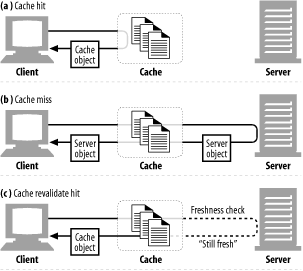Hits and Misses
So caches can help. But a cache doesn’t store a copy of every document in the world.[3]
Some requests that arrive at a cache can be served from an available copy. This is called a cache hit (Figure 7-4a). Other requests arrive at a cache only to be forwarded to the origin server, because no copy is available. This is called a cache miss (Figure 7-4b).

Figure 7-4. Cache hits, misses, and revalidations
Revalidations
Because the origin server content can change, caches have to check every now and then that their copies are still up-to-date with the server. These “freshness checks” are called HTTP revalidations ( Figure 7-4c). To make revalidations efficient, HTTP defines special requests that can quickly check if content is still fresh, without fetching the entire object from the server.
A cache can revalidate a copy any time it wants, and as often as it wants. But because caches often contain millions of documents, and because network bandwidth is scarce, most caches revalidate a copy only when it is requested by a client and when the copy is old enough to warrant a check. We’ll explain the HTTP rules for freshness checking later in the chapter.
When a cache needs to revalidate a cached copy, it sends a small revalidation request to the origin server. If the content hasn’t changed, the server responds with a tiny 304 Not Modified response. As soon as the cache learns ...
Get HTTP: The Definitive Guide now with the O’Reilly learning platform.
O’Reilly members experience books, live events, courses curated by job role, and more from O’Reilly and nearly 200 top publishers.

